It was 20 years ago today… Stuart Sutcliffe, Astrid Kirchherr, Klaus Voorman, Jurgen Vollmer, and The Beatles
 Astrid Kirchherr and Stuart Sutcliffe. Self-portrait © Astrid Kirchherr
Astrid Kirchherr and Stuart Sutcliffe. Self-portrait © Astrid Kirchherr
It was 20 years ago today that Govinda Gallery hosted the first exhibition of former Beatle Stuart Sutcliffe’s paintings and drawings in the United States. Sutcliffe was with the Beatles in Hamburg, Germany during their formative years in the early 60s, during which time they developed their identity transforming from the 50s rockers look with Elvis Presley haircuts to the “mop top” look they became known for. It was their friends in Hamburg, Klaus Voorman, Astrid Kirchherr, and Jurgen Vollmer who influenced them in many ways including Jurgen Vollmer giving John and Paul their first Beatles haircut. Stuart, an extraordinarily talented artist, died tragically of a brain aneurism in Hamburg at the age of 21 in 1961.
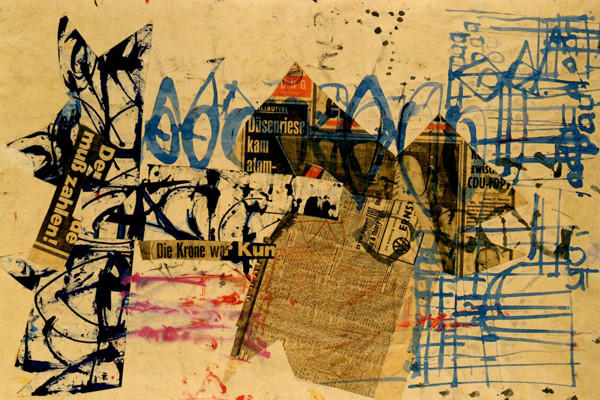 Hamburg, Mixed media on paper, © Stuart Sutcliffe.
Hamburg, Mixed media on paper, © Stuart Sutcliffe.
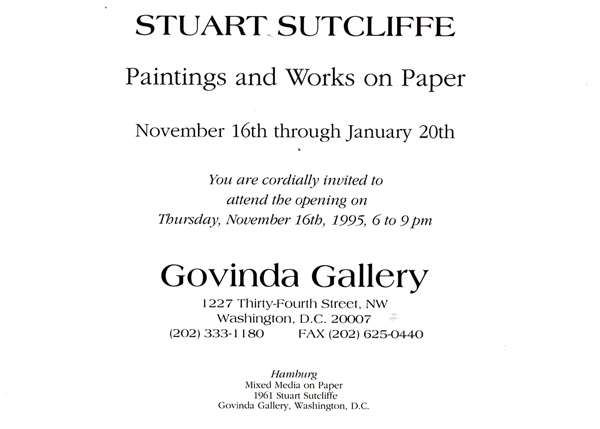
This summer I visited my dear friends Jurgen and Astrid in Hamburg along with Gibson Kemp who was in the Merseyside band Paddy, Klaus, & Gibson. Astrid and Jurgen had the first exhibitions of their photographs at Govinda Gallery. Klaus Voorman’s extraordinary artwork was also exhibited at Govinda Gallery. Voorman’s art is well known, especially form his black and white drawing on the cover of The Beatles album Revolver.
 “Elvis McCartney” © Klaus Voorman.
“Elvis McCartney” © Klaus Voorman.
Richard Harrington at The Washington Post wrote a terrific feature story on Stuart Sutcliffe’s exhibition which opened on November 16, 1995. That story is presented here in full.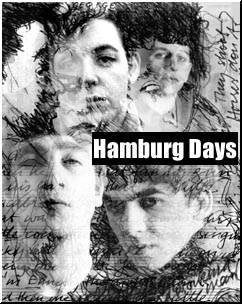
Govinda Gallery represented the estate of Stuart Sutcliffe for several years. His work was also featured in the legendary exhibition Hamburg Days at Govinda Gallery, which was also a launch for the limited edition book of the same name from Genesis Publications.
Here are several photos of Astrid Kirchherr, Gibson Kemp, and Jurgen Vollmer taken this past August in Hamburg. If you find yourself in Hamburg be sure to visit Kemp’s English Pub and say hello to Gibson and his wife Tina.
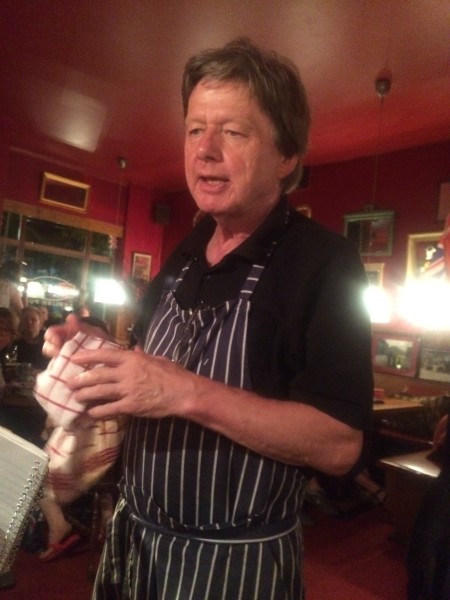 Gibson Kemp at Kemp’s English Pub in Hamburg. © Carlotta Hester.
Gibson Kemp at Kemp’s English Pub in Hamburg. © Carlotta Hester.
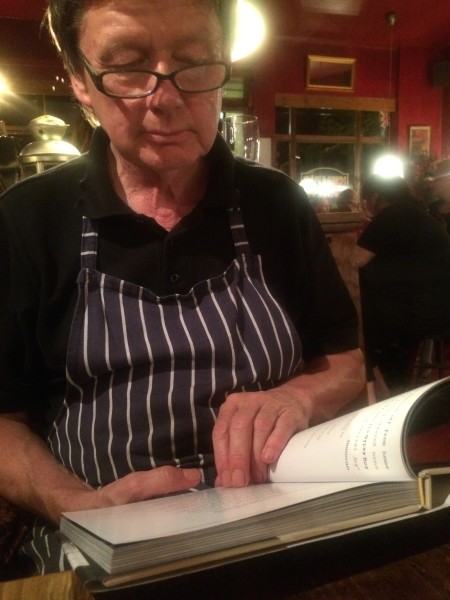 ‘Gibbo’ enjoying Ted Russell’s book of photographs Bob Dylan NYC 1961-1964 (Rizzoli). © Carlotta Hester.
‘Gibbo’ enjoying Ted Russell’s book of photographs Bob Dylan NYC 1961-1964 (Rizzoli). © Carlotta Hester.
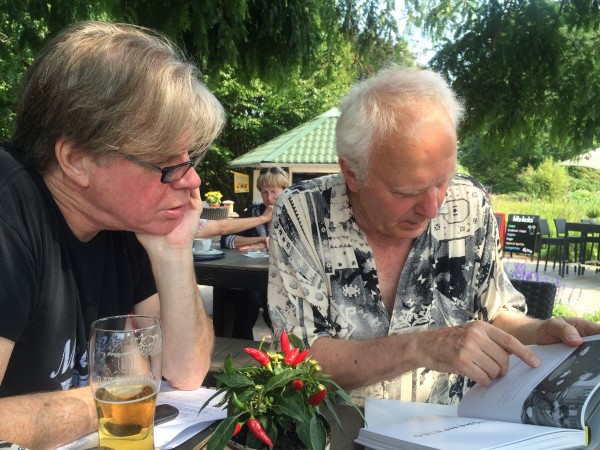 Govinda Gallery director Chris Murray with Jurgen Vollmer at the Botanical Garden in Hamburg. Jurgen is also enjoying a copy of Ted Russell’s book of early photos of Dylan. © Carlotta Hester.
Govinda Gallery director Chris Murray with Jurgen Vollmer at the Botanical Garden in Hamburg. Jurgen is also enjoying a copy of Ted Russell’s book of early photos of Dylan. © Carlotta Hester.
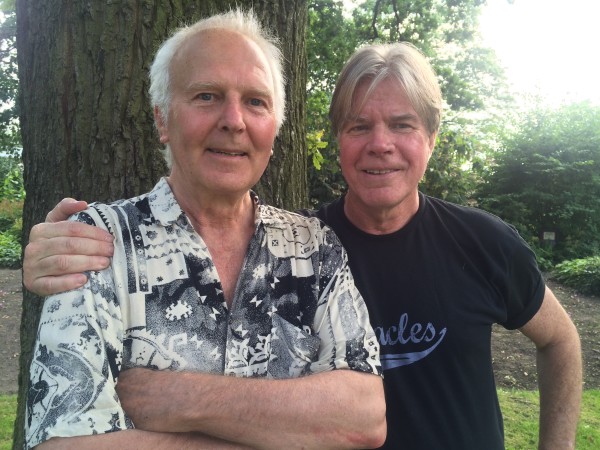 Jurgen and Chris © Carlotta Hester.
Jurgen and Chris © Carlotta Hester.
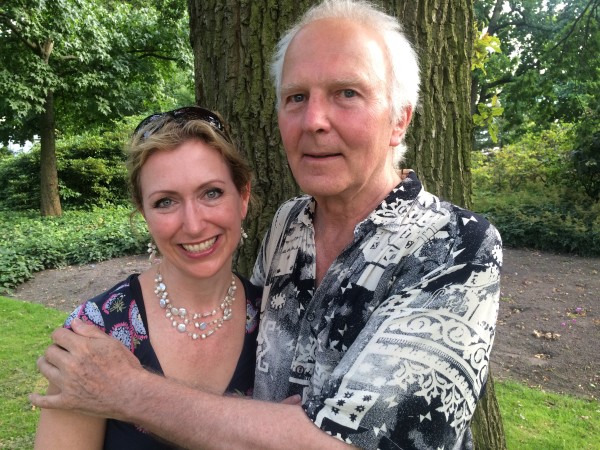 Carlotta Hester and Jurgen Vollmer. © Chris Murray
Carlotta Hester and Jurgen Vollmer. © Chris Murray
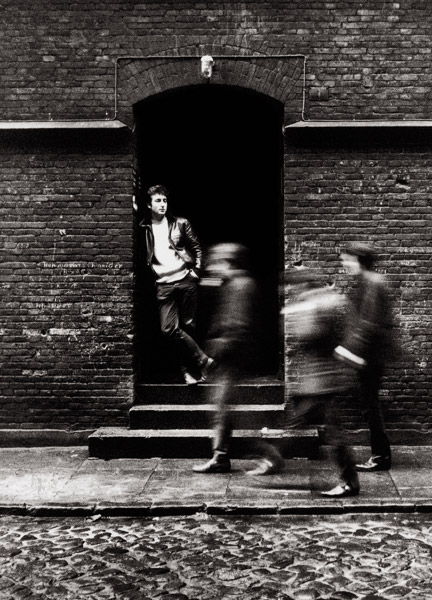 John Lennon, Doorway in Hamburg. The cover of Lennon’s album Rock and Roll © Jurgen Vollmer
John Lennon, Doorway in Hamburg. The cover of Lennon’s album Rock and Roll © Jurgen Vollmer
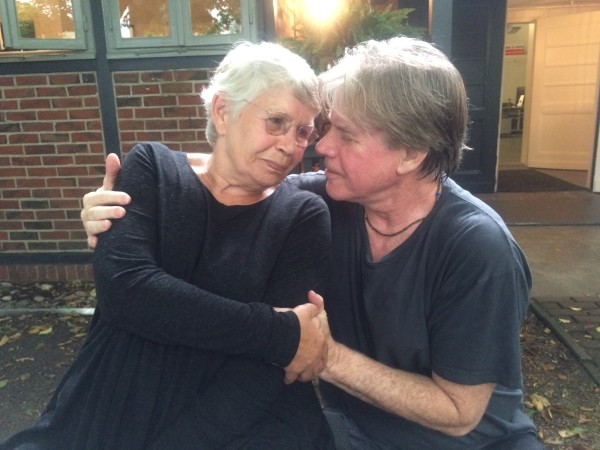 Old friends… Astrid Kirchherr and Chris Murray. © Carlotta Hester.
Old friends… Astrid Kirchherr and Chris Murray. © Carlotta Hester.
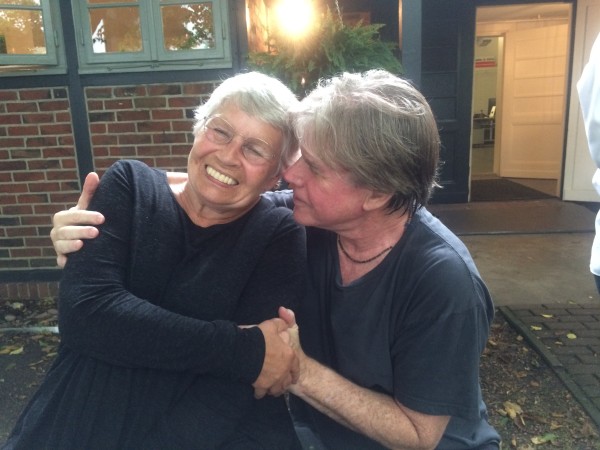 Astrid and Chris. © Carlotta Hester.
Astrid and Chris. © Carlotta Hester.
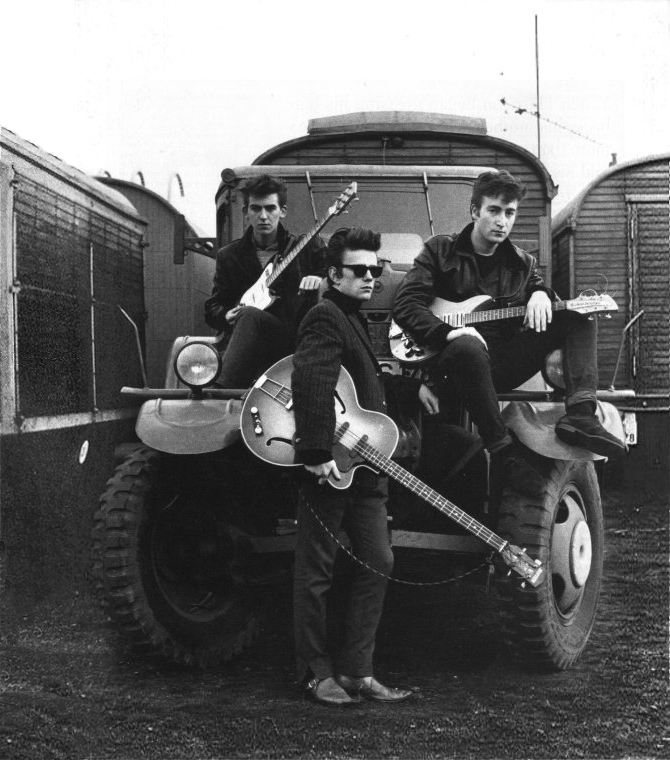 John, George, and Stuart at HH Fair in Hamburg. © Astrid Kirchherr
John, George, and Stuart at HH Fair in Hamburg. © Astrid Kirchherr
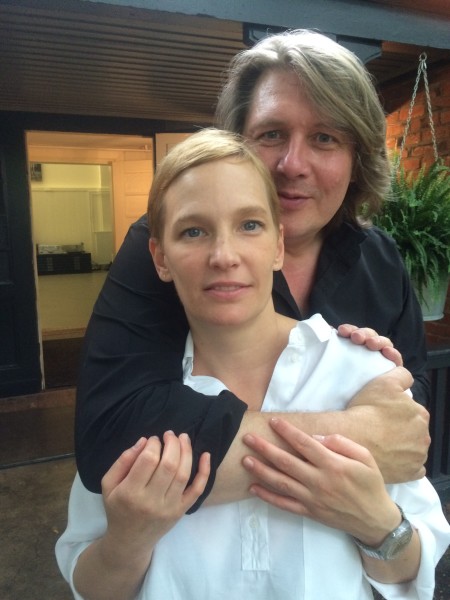 Photographer Kai Uwe Franz, archivist and studio manager for Astrid Kirchherr, with his wife photo editor extraordinaire Julia Franz. © Carlotta Hester.
Photographer Kai Uwe Franz, archivist and studio manager for Astrid Kirchherr, with his wife photo editor extraordinaire Julia Franz. © Carlotta Hester.
Astrid Kirchherr, Klaus Voorman, Jurgen Vollmer, and Stuart Sutcliffe’s work is available at Govinda Gallery.
From Bass to Brush
Stuart Sutcliffe’s Other Passion on Display
By Richard Harrington
November 5, 1995
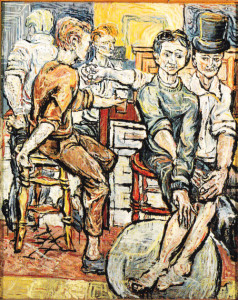 Last year, the film “Backbeat” told the tragic and not widely known story of Stuart Sutcliffe, the young Liverpool painter who was the Beatles’ original bassist before leaving in 1960 and choosing art over music. Sutcliffe never saw the Beatles rise to the iconic status we are all familiar with: He died in April 1962 of a massive brain hemorrhage at age 21.
Last year, the film “Backbeat” told the tragic and not widely known story of Stuart Sutcliffe, the young Liverpool painter who was the Beatles’ original bassist before leaving in 1960 and choosing art over music. Sutcliffe never saw the Beatles rise to the iconic status we are all familiar with: He died in April 1962 of a massive brain hemorrhage at age 21.
“Backbeat” told several stories: of the Beatles’ origins, influences and search for an original sound in the bars of Hamburg, Germany; of the deep friendship between Sutcliffe and John Lennon (a year behind him at the Liverpool College of Art); of Sutcliffe’s conflicted creative instincts; and particularly of the rich relationship he shared with German photographer Astrid Kirchherr.
What the film didn’t, and perhaps couldn’t, show was the actual art that so consumed Sutcliffe. That will finally be on display in “Stuart Sutcliffe: Paintings and Works on Paper” at Govinda Gallery in Georgetown now through Jan. 20.
It is the first major exhibition of Sutcliffe’s work, which ranges from a lively impressionistic pub portrait to abstract expressionist canvases. The paintings are quite good—and there’s the rub, according to his younger sister, Pauline Sutcliffe, who will fly over for the opening. Recognition for her brother’s art has always faced two hurdles: his early death and fame by association.
“Despite all the modern work we see today, the art Establishment is as traditional and reactionary as it ever was,” Pauline Sutcliffe says, noting that “part of [its] position is that an artist of 21 going on 22 cannot possibly, no matter if there are real flashes of talent, be regarded as a mature artist.”
As for the Beatles connection, it “has both opened and slammed doors,” she says, with some critics suggesting that it was only that link that made the work interesting. “For years and years, we were trying to cast that [connection] aside,” Sutcliffe says. Now, she adds, “we realize that it is a fact of life that add another piece of fascination for many people.”
Sutcliffe is also author, with Kay Williams, of “Stuart: The Life and Art of Stuart Sutcliffe,” a hand-bound, limited edition biography forthcoming from Genesis Publications that includes color plates, private photos and personal letters, and a facsimile reproduction of an entire sketchbook of Hamburg.
“Well before Stuart went to art school, he was a young man who painted and drew all the time,” Sutcliffe recalled from her London home last weekend. Music, she says, was part of the mix as well, and when Sutcliffe first met Lennon in the fall of 1957 at Liverpool College of Art, they shared a passion for American R&B and rock-and-roll, as well as for stylish fashion, beat poetry and existential attitudinizing.
Sutcliffe, however, was clearly the more gifted artist, as evident in his sketches and the large oil on board titled “Ye Cracke.” On display at Govinda, it is one of the earliest Sutcliffe works, a Van Gogh-style group portrait of denizens of a small student hangout near the college. Sutcliffe was only 17 when he finished it, but one can sense considerable talent and a flair in its vivid colors and lines.
In 1958 Sutcliffe actually sold a painting and, after being persuaded by Lennon and Paul McCartney to buy a Hohner President electric bass, joined their fledgling band, the Quarry Men. Thus began a combination of art and music that would consume Sutcliffe’s energies and upset some of his teachers, who believed that a potentially brilliant artist was being lured away from his true gift.
Ironically, it was the Beatles’ journey to Hamburg that refocused Sutcliffe on his art (in truth, he was never much of a musician). The Govinda show includes a number of large paintings done there (only a dozen or so remain). His work had clearly evolved and the canvases (often a deep, dark color) are quite dramatic and highly worked in terms of texture. As “Backbeat” suggested, Sutcliffe expended a lot of physical energy when he painted.
The bulk of the show consists of works on paper representing a variety of approaches after Sutcliffe abandoned realism, including collages that showed the influence of abstract expressionists in America (Rothko, de Kooning) and their European influences (Braque, Picasso). Some works show a Zenlike approach to brush strokes, with classic black calligraphy over newsprint.
While the Beatles connection had some attraction (he wrote home that “people refer to me as the James Dean of Hamburg… I’m flattered”). Sutcliffe became increasingly focused on his art. In another letter, he wrote: “When I have something to give I will give it. …When I have something to say I will say it in paint, in stone or anything my soul touches.”
Unfortunately, he became increasingly ill. His sister’s biography includes a remarkable sampling of letters Sutcliffe sent to his mother and sisters and to friends back in Liverpool and elsewhere that reflect on his experiences as a Beatle, his desire to return to the world of art and his deepening love for Kirchherr. As the letters became more disjointed, they reflect a deteriorating spirit and physical condition, the cause of which was not identified despite numerous medical tests and examinations.
Two years after Stuart Sutcliffe’s death, there was a memorial exhibition of his work at Liverpool’s Walker Art Gallery, and three years later it was included in an exhibition at London’s Institute of Contemporary Arts.
By then his mother, Millie Sutcliffe, had begun a crusade for increased public recognition of his art that lasted until her death in 1983. These days that responsibility has fallen to sister Pauline, who acted as art adviser to “Backbeat.”
“I certainly don’t do it with the same intensity as Mother did, because I am a professional working woman,” says Sutcliffe, a family psychotherapist. Her mother was “stimulated in her quest by the very keen interest of John Willet, the director of the Walker Art Gallery, who did pronounce the work certainly of significance and ability.
“…That gave her the impetus to believe beyond simply a mother’s adoration for her boy.”